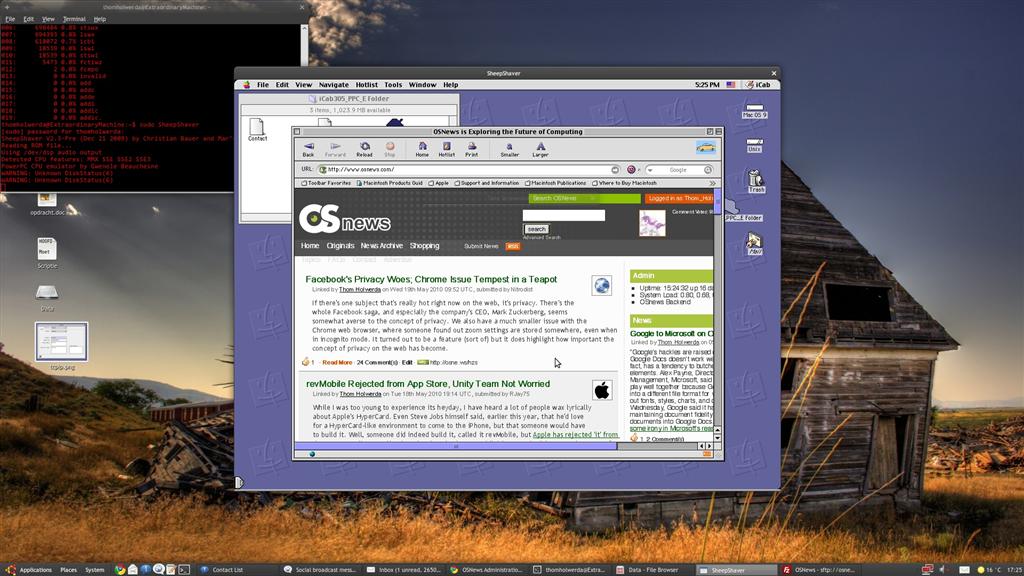
- #UBUNTU FOR MAC POWERPC FOR MAC#
- #UBUNTU FOR MAC POWERPC ISO#
- #UBUNTU FOR MAC POWERPC DOWNLOAD#
#UBUNTU FOR MAC POWERPC DOWNLOAD#
Just make sure you pick a download that has "powerpc" in it.
xUbuntu 13.04 can be found here: and 12.10 can be found here Īnd if you want to be even more adventurous:. LUbuntu 13.04 can be found here: and 12.10 here: #UBUNTU FOR MAC POWERPC FOR MAC#
Server install image for Mac (PowerPC) and IBM-PPC (POWER5) computers (jigdo download) Server install image for Mac (PowerPC) and IBM-PPC (POWER5) computers (BitTorrent download) Server install image for Mac (PowerPC) and IBM-PPC (POWER5) computers (standard download)
Desktop image for Mac (PowerPC) and IBM-PPC (POWER5) computers (BitTorrent download). Desktop image for Mac (PowerPC) and IBM-PPC (POWER5) computers (standard download). I’ll be happy to show off my Frankenstein’s monster of technology.See: and all the options that have powerpc in the name. If you want to see first-hand the PowerBook G4 running Linux and you’re attending MacStock July 15 and 16, find me. In a future article, I’ll outline how you can go about doing that. If that doesn’t work out, you might consider a netinstall of Linux. I won’t go into the finer details of partitioning the disk, since the assumption here is that your installed version of OS X is too dated for you to want to keep it. Once it boots up, which could take some time, simply follow the instructions to get your PowerPC Mac up and running using Linux. Replace usb0 with the actual device alias you found previously. Booting Your PowerPC Mac Into the USB Linux Installationįinally, type this to boot from that device. Find the one matching your USB device (usb0, ,1, etc). This gives you a list of aliases for the devices. Take note of what it’s called, then type this: devalias If not, type this at the prompt: probe-usb Hopefully, one of them will have beneath it. Look through the list of devices for an entry like usb0, ,1, etc. Now, find out if your USB disk has shown up. Keep holding those four keys down until you see the OpenFirmware prompt. When you hear the startup chime, make sure you’re pressing and holding Command-Option-O-F. To get into OpenFirmware, you’ll need to reboot your PowerPC-based Mac. Note that not all PowerPC-based Macs support this, but most do. This is how you might do a net boot, for instance, or boot from a USB drive. Many PowerBooks and other PowerPC-based Macs use OpenFirmware, allowing you to boot from devices that don’t show up otherwise. Using OpenFirmware to Find Your USB Installer Once done, you’ll be ready to insert the USB installer into your PowerPC-based computer and boot from the stick. It’ll take a few moments (or longer) to complete. dd if="/Users//Downloads/lubuntu.iso" of=/dev/disk2 bs=1m Change “lubuntu.iso” to the proper filename, and be sure to use your disk identifier in the of= parameter. Go ahead and issue this command in Terminal to create the USB installer drive. You’ve got your USB flash drive prepped, and you know what to call it. Once that step completes, it will be time to create the USB flash drive installer you need to start installing Linux. Do this by typing this command in Terminal, replacing disk2s3 with the device identifier for your USB flash drive: Now, we’re going to unmount the USB flash drive so we can work directly with it in Terminal. It should be something like /dev/disk2s3. Look for the name of the USB flash drive, and remember what it’s called. In Terminal, find out the device ID for your USB Flash drive. #UBUNTU FOR MAC POWERPC ISO#
Take note of what the filename is for your ISO image of Lubuntu 16.04.

Heck, even if you aren’t comfortable, the job can be done. If you are comfortable with Terminal on your newer Mac, this is still pretty simple. Just burn the ISO to a blank DVD, insert it into your PowerBook or other PowerPC-based Mac, and press the “C” key while the computer boots up. Because of this, I had to create USB install media.Īssuming you’re fortunate enough to be able to boot from a DVD, it’s really simple.

My PowerBook G4 has a CD-R/W drive, though. If you have a DVD drive, you can simply burn the ISO image of Lubuntu 16.04 to a disk and start that way. What you need to get started depends on what type of optical drive you have in your G4- or G5-based PowerBook or Mac. Getting the Revival on for Your PowerPC Mac Running Linux
Create and edit Word documents and Excel spreadsheets using LibreOffice. Write Markdown documents using Remarkable, a very excellent Markdown editor. What Can You Do With Older Hardware?Ĭurious what you might be able to accomplish with a PowerPC-based laptop? Here’s what I’ve been able to accomplish so far, since I revived my PowerBook G4 and brought it up-to-date with a Lubuntu installation. The beauty here is that PowerPC is still alive, well, and fairly well supported. My current build is running Lubuntu, a lightweight flavor of Ubuntu.






 0 kommentar(er)
0 kommentar(er)
